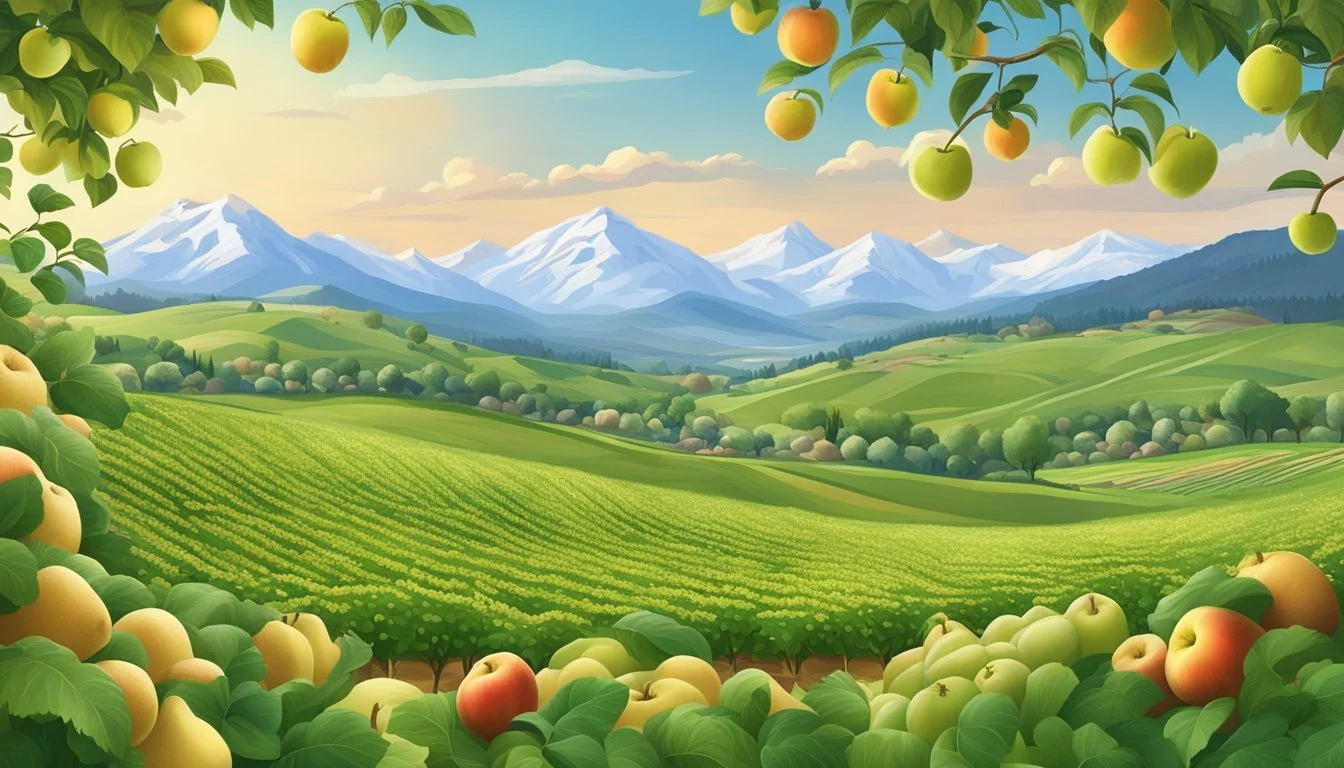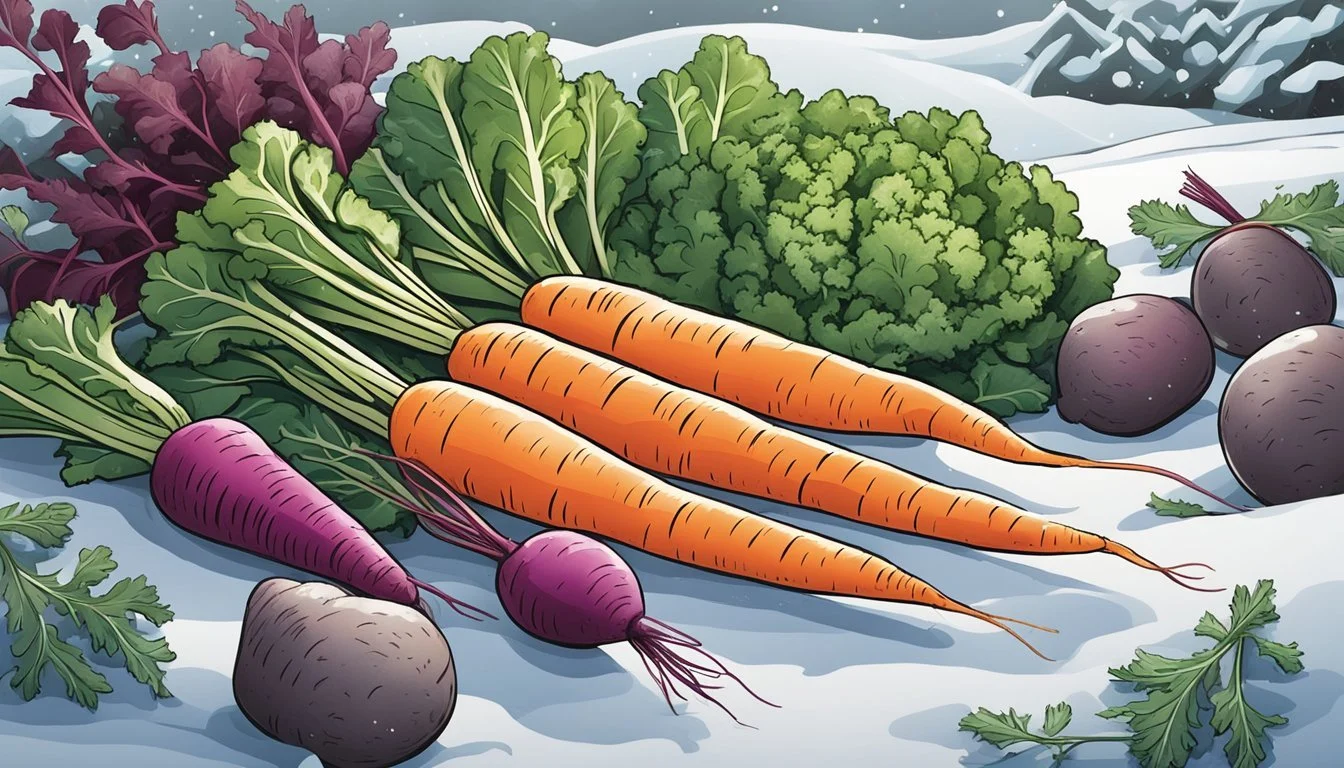Idaho Seasonal Fruit & Vegetables in January
Your Guide to Fresh Produce
This Article is Part of our Idaho Seasonal Fruit & Veg Calendar
January in Idaho is a time for hearty, nutritious produce that can withstand the cold winter months. During this period, the state offers a variety of fruits and vegetables that are not only fresh and locally grown but also highly beneficial for health. Root vegetables and sturdy greens dominate the selection, providing essential nutrients and flavors that complement the season. Hearty kale, for instance, is abundant and offers versatility for a range of dishes, from salads to soups.
Citrus fruits, while not native to Idaho's climate, are often at their peak in other growing regions during January and are readily available in Idaho markets. They provide a fresh, bright flavor and are packed with vitamins, particularly vitamin C, which is great for boosting the immune system during the colder months. In addition to citrus, storage crops like onions and potatoes are staples, having been harvested in the fall and kept in conditions to maintain their freshness throughout the winter.
Broccoli (how long does broccoli last?) and cauliflower (how long does cauliflower last?) also feature prominently in Idaho's January produce, offering both robustness and adaptability in various culinary applications. These cruciferous vegetables come into their own during these chillier months, ensuring that Idahoans have access to fresh, flavorful produce that supports both local agriculture and healthy eating habits during the winter.
Understanding Idaho's Seasonal Produce Cycle
In Idaho, the seasonal produce cycle is closely tied to the state's distinct weather patterns, which greatly influence the availability of fruits and vegetables throughout the year. In January, as winter holds the region in its grasp, selections tend to favor hardy, cold-tolerant produce.
Vegetables: January's chill calls for storage vegetables and those capable of withstanding frost. Consumers can find a variety of root vegetables and winter greens. Availability is typically indicated by color coding on regional charts—dark green for plentiful supply and light green for limited availability.
In Season Vegetables Availability Status Beets Dark Green Carrots (how long do carrots last?)Dark Green Garlic Dark Green Onions Dark Green Potatoes Dark Green Winter Squash Dark Green Kale Dark Green Turnips Light Green Winter Greens Light Green
Fruits: Fruit options in January are narrower since most fruit crops are not in season during the winter months. Storage apples (how long do apples last?) or pears from the previous fall may still be accessible, but options will depend on the local storage and distribution capabilities.
The seasonality of produce in Idaho mirrors the state's agricultural data, reflecting a cycle adapted to local climate zones. Though the range is more limited than during bountiful summer months, January still offers a selection of produce. These items are prime for dishes suited to colder weather, fitting nicely into hearty, warm meals that align with both the climate and dietary preferences during this time of year.
January's Harvest in Idaho
In January, Idaho's fields yield a limited but valuable variety of fresh and seasonal produce. Root vegetables and hardy winter greens are predominantly ready for harvest during this chilly month. Consumers can anticipate the availability of several nutrient-rich vegetables.
Vegetables:
Kale: A hearty leafy green, kale is robust during the Idaho winter.
Broccoli: This cruciferous vegetable is a staple, with florets available in January.
Cauliflower: Similar to broccoli, it is ready for harvest and rich in nutrients.
Romanesco: This architecturally interesting variant of cauliflower is a January highlight.
Fruits: While fruit options are more limited, certain citrus fruits reach peak ripeness and are featured in Idaho's January produce.
Citrus Fruits: Oranges and lemons, though not native, are fresh choices during the winter months.
Consumers seeking food that is both fresh and in season, find that these choices are excellent for nutritious meals. While Idaho is renowned for its potatoes, they, along with several other root vegetables, are typically harvested before January and stored for distribution throughout the winter. It is important for buyers to note that the actual availability of produce can vary based on specific regional climates and current weather conditions.
Featured Fruits Available in January
January in Idaho showcases a variety of fruits that are notable for their freshness and flavor during the winter months. Although the variety may be less extensive than in the summer, shoppers can still find high-quality fruit.
Citrus fruits are particularly prominent during this time. Oranges and lemons are in good supply, providing vibrant flavors and essential Vitamin C which is beneficial during the colder days. Oranges are excellent both as a juicy snack and as a bright addition to winter salads, while lemons add a refreshing zest to both savory and sweet dishes.
Grapefruits also make a significant appearance. Their bittersweet taste is a favorite for breakfasts and can also be a part of invigorating fresh juices (how long do fresh juices last?).
Citrus Fruits Availability Oranges High Lemons High Grapefruits Moderate
Moving away from citrus, consumers will find that certain varieties of apples and pears are still accessible. These fruits, stored carefully from the fall harvest, retain their crisp texture and are versatile for cooking or raw consumption.
Pome Fruits Storage Quality Notes Apples Crisp Ideal for pies Pears Firm Excellent poached
These fruits provide a foundation for nutritious eating during Idaho's colder months. Consumers can enjoy these offerings knowing they are consuming seasonal produce at its peak of freshness.
Highlighted Vegetables for January
In Idaho, January's cool temperatures shape a distinctive range of root vegetables and hardy greens. Consumers can appreciate a bounty of wholesome choices during this chilly month.
Root Vegetables: Root varieties endure the cold well, making them staple choices for January. Beets and carrots, with their earthy flavors, (What wine goes well with earthy flavors?) are at their sweetest now. Potatoes and sweet potatoes, versatile in use, also remain widely available and are perfect for warm comfort dishes.
Hearty Greens: Kale, sought-after for its nutrition, thrives in colder weather and offers a robust flavor. It's an excellent addition to soups and salads.
Cruciferous Vegetables: Broccoli and cabbage withstand winter's frost. These nutrient-packed vegetables provide ample opportunities for healthy and hearty meals. Broccoli's tight florets and cabbage's dense leaves are both excellent for roasting or incorporating into stews.
Alliums and More:
Onions and celery, essential for flavor bases in various recipes, are plentiful. Their presence in stocks and soufflés is almost indispensable.
Celery, apart from its use in mirepoix, offers a crisp texture to winter salads.
Consumers will find these vegetables easily accessible at local Idaho markets, ensuring peak freshness and flavor. They represent some of the best produce options for January meals, promoting both health and seasonal eating habits.
Seasonal Eating Benefits and Tips
Eating seasonally is the practice of consuming fruits and vegetables that are harvested at the peak of their freshness and ripeness. This approach to diet not only contributes to a more flavorful plate but also offers a range of health benefits.
Freshness: Seasonal produce is fresher and tends to be more nutritious as it is harvested at the optimal time for taste and nutrient density.
Healthy: A diet rich in seasonal fruits and vegetables supports overall health, potentially reducing the risk of chronic diseases.
Variety: Rotating foods with the seasons adds diversity to meals, important for obtaining a broad range of nutrients.
January in Idaho typically means root vegetables and hearty greens, which are perfect for nutritious winter recipes such as stews. These dishes can provide both warmth and nourishment during the colder months.
When selecting produce, look for signs of freshness such as vibrant color and firm texture. Supporting local agriculture by choosing Idaho-grown seasonal produce ensures one receives fruits and vegetables at their peak. Here's a brief list of what might be in season:
Vegetables Fruits Brussels sprouts (how long do brussels sprouts last?) Apples Potatoes Pears Onions Carrots Winter squash
Incorporating these foods into one's diet can maximize flavor and nutritional benefits. Cooks and consumers alike can take advantage of the robust flavors these seasonal offerings impart, experimenting with different preparations to suit their palate.
Navigating Idaho's Food Calendar
January in Idaho offers a more limited selection of fresh produce due to the cold climate. However, understanding the food calendar helps consumers find available local goods and supports regional agriculture.
Fruits during this time are generally limited to storage crops from the previous harvest season. Apples are a staple, reliably found in markets throughout the winter months.
Fruit Availability Apples High Bananas Low (Imported)
Vegetables are also restricted, but certain hearty storage varieties and greenhouse-grown produce maintain presence.
Vegetables Availability Brussels Sprouts Medium Beets Medium Cabbage Medium Carrots Medium Potatoes High
Shoppers can refer to various resources, including local agricultural guides or printable online calendars, to ascertain the peak times for fresh local produce. The Idaho Preferred program offers materials to educate on the seasonality of Idaho's produce, ensuring that one can purchase the ripest fruits and vegetables when they are at their best.
It is essential to recognize that availability can vary across the state and year to year. Regional variations and unique weather patterns can slightly shift the calendar, so consumers are encouraged to engage with local farmers and markets for the most accurate information.
Preparation and Cooking of January Produce
Brussels Sprouts: A versatile winter vegetable, they thrive in the cold climate of January and can be transformed beyond the often disliked boiled form. Roasting Brussels sprouts enhances their flavor, giving them a crispy exterior and tender interior. They can be paired with a variety of sauces or incorporated into a hearty stew.
Recipe Suggestion: Roasted Brussels sprouts with balsamic glaze and pancetta.
Root Vegetables: Including beets, carrots, and potatoes, root vegetables are staple foods during the colder months in Idaho. These can be roasted to bring out their natural sweetness or baked in a casserole.
Recipe Suggestion: Savory roasted root vegetables with herbs.
Winter Squash: With varieties like butternut and acorn, winter squash provides a comforting sweetness and is ideal for both baking and roasting. It can be pureed for soups or stuffed for an entrée.
Recipe Suggestion: Baked acorn squash with maple glaze.
Fruits: While much of the produce in January consists of root vegetables and hearty greens, fruits like pears and apples still offer fresh flavors. They can be baked into desserts or added to salads for a crisp, sweet contrast to the earthy flavors of winter vegetables.
Recipe Suggestion: Pear and apple crisp with a cinnamon oat topping.
In summary, January produce in Idaho can be utilized in a myriad of ways beyond simple preparations. Emphasizing roasting and baking techniques not only enriches the food's flavor but also aligns well with the need for warmth and comfort during the winter season.
Where to Find Fresh Produce in Idaho
In Idaho, consumers eager to enjoy fresh, seasonal produce have a wealth of options. Throughout the state, a network of farmers' markets offers a platform where local farmers can sell their freshly harvested fruits and vegetables directly to the public. These markets typically feature an abundance of produce that varies according to the season.
Local farms in Idaho also open their doors for visitors looking for farm-fresh goods. Many farms offer the chance for consumers to pick their own fruits and vegetables, ensuring the freshness and seasonality of their purchase.
For convenience, several specialty stores and co-ops within the state focus on providing local, fresh produce. These establishments build close relationships with Idaho farmers to stock a variety of seasonal items.
Here's a quick reference for places to find fresh produce in Idaho:
Farmers' Markets: The heart of local produce, offering a variety of seasonal fruits and vegetables.
Pick-Your-Own Farms: A fun and engaging way to source fresh produce right from the field.
Specialty Stores: Retailers that prioritize local and fresh options for Idaho consumers.
Co-ops: Community-centric hubs that source from multiple local farms to ensure a range of fresh, seasonal products.
When one shops at these locations, not only do they get access to produce at the peak of freshness, but they also support the local economy and contribute to sustainable food practices within the state.
Fostering Local Agriculture
One of Idaho's economic cornerstones is its agriculture sector, heavily influenced by the state's favorable weather conditions and a dedication to nurturing seasonal crops. By focusing on locally harvested produce, Idaho not only bolsters its economy but also ensures a greener footprint and fresher food options for its residents.
In January, support for local agriculture revolves around understanding which crops can thrive in the colder climate. Farmers in Idaho leverage both natural weather cycles and advanced agricultural techniques to supply a range of hardy vegetables and storage crops during this time.
Seasonal Crops:
Winter squash
Potatoes
Onions
Beets
Carrots
Cabbage
These crops, once harvested, provide a foundation for the local economy, encouraging consumers to invest in their community by purchasing locally grown goods. This support goes beyond just the economic aspect—it fosters a closer connection between Idahoans and the land they live on.
Idaho's weather conditions, while diverse, typically lend themselves to the growth of robust winter crops and the storage of autumn-harvested fruits such as apples. Farmers adapt to the seasonal constraints by focusing on crops that can endure the colder temperatures, ensuring that agriculture remains a stable industry even in the chill of January.
Consumers contribute to the vitality of Idaho's agricultural scene by participating in initiatives like Community Supported Agriculture (CSA), where they purchase shares of a farm's produce ahead of the season. This practice directly supports farmers giving them a reliable market for their crops and allowing consumers to receive fresh, local produce regularly.
Conservation and Seasonal Food Choices
Making food choices based on what is in season is a sustainable step toward conservation and ecological mindfulness. In Idaho, individuals opting for seasonal produce in January contribute to a cycle that supports local agriculture and reduces the carbon footprint associated with long-distance food transportation.
Benefits of Seasonal Food:
Supports local farmers: Seasonal purchases incentivize local production and contribute to the local economy.
Enhances flavor and nutrition: Fruits and vegetables harvested at their peak often taste better and may retain more nutrients.
Reduces transportation: Local, in-season produce requires less transport, lowering greenhouse gas emissions.
Idaho's January Seasonal Produce:
Vegetables: Consumers can find options like potatoes and winter squash that are harvested in the fall and stored for winter use.
Fruits: Storage crops such as apples and pears remain on the shelves from the previous season's harvest.
Ecological Impact:
Consumers' food choices directly affect the demand that drives agricultural practices. When they choose local, seasonal items, they encourage a continuation of more sustainable farming methods.
Sustainable Agriculture Practices:
Crop rotation
Cover cropping
Reduced tillage
These practices improve soil health and water conservation, contributing to a system that supports the environment. Thus, consumers can see choosing seasonal and local produce as an act of partnership with their local ecosystem, ensuring its vitality for future generations.
Appendix: Idaho Seasonal Food Map
In January, Idaho’s seasonal food map offers a modest variety of produce due to the cold climate. Individuals looking for locally grown fruits and vegetables during this month will find options are limited primarily to storage crops and hearty winter greens.
Vegetables:
Potatoes: A staple of Idaho, available all year.
Onions: Also available throughout the year.
Carrots: Generally stored and accessible in January.
Beets: Similar to carrots, they are often available from storage.
Winter Squash: Includes varieties like butternut and acorn squash; in storage from fall harvest.
Fruits:
Apples: These remain accessible from storage, maintaining quality after harvest.
Pears: Like apples, pears are typically stored, remaining fresh for months.
The state's produce selection in January heavily focuses on storage capabilities, where root vegetables and hardy fruits with longer shelf lives are predominant. The limited fresh produce is due to Idaho’s seasonal growing conditions, which do not favor a wide range of fresh fruits and vegetables during the colder months. The map reflects this, showing availability primarily in storage facilities rather than fields.
Buyers should note the color coding indicative of availability:
Dark Green: Widely available; peak storage or still in season.
Light Green: Limited availability; start or end of the storage season.
White or Gray: Not available or out of season.
The Idaho seasonal food map serves as a guide to what one might expect at local markets, enabling informed decisions when seeking out the freshest local produce during the winter month of January.
Conclusion
January in Idaho offers a variety of produce despite the cold weather. Root vegetables and hearty greens, which can withstand the colder temperatures, are typically available and provide the foundation for nutritious winter meals.
Seasonal Availability:
Vegetables: Hearty greens like kale, along with cruciferous vegetables such as broccoli and cauliflower, are in good supply. These vegetables are not only versatile in meal preparation but also rich in nutrients.
Fruits: Citrus fruits shine in January, offering a burst of flavor and vitamin C, which is particularly beneficial during the cold season for its immune-boosting properties.
Considerations for Local Produce:
Hearty vegetables can be incorporated into a wide range of dishes, from soups to roasts.
Citrus fruits add a fresh element to winter dishes and can be used in both sweet and savory recipes.
Local consumers should take advantage of these seasonal items for the freshest quality and to support Idaho farmers. Planning meals around available produce can lead to more sustainable eating habits and helps in maintaining a closer connection to the local food system.














